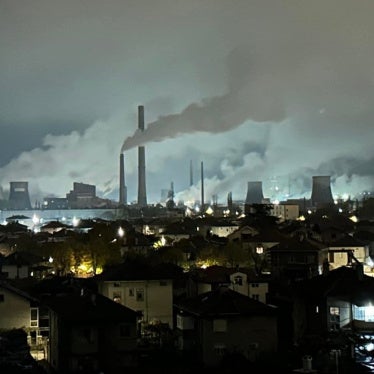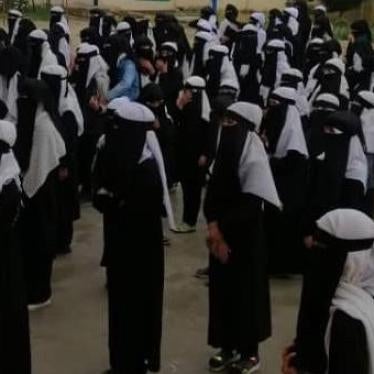LUHANSK, Ukraine — You smell it before you see it. With no electricity and a steady stream of casualties, Luhansk's morgue is struggling to keep up. On Thursday, Aug. 21, lined up on the lawn outside were 17 bodies -- bloated, engulfed in buzzing flies -- while the staff cleaned the refrigerators, hoping that they would soon restart after several weeks of power outage.
Nearly four months after the conflict in eastern Ukraine between government forces and pro-Russian separatists began in earnest, the war grinds on. The Ukrainian army has retaken some towns, closing in on Donetsk, the largest city in the area, which has come under increasingly heavy bombardment. In other places, separatist forces have launched counteroffensives, retaking the city of Novoazovsk and moving in on Mariupol.
But it is, perhaps, the residents of Luhansk who have been in the crossfire the longest. Normally home to nearly half a million people, the city felt like a ghost town when I arrived there recently. Locals arriving on the afternoon train rushed to the relative safety of their homes. There has been virtually no electricity and running water in the city for weeks. Stores are nearly empty. Cell phones and landlines rarely work.
In the morning, it becomes clear that the city is far from empty. Starting at around 6 a.m., hundreds of local residents line up for bread and water at distribution points around Luhansk. Dozens gather at the two points in the city where, if you are patient, you can catch cell-phone reception from a tower in a neighboring town. And they come to the central market as soon as it opens to buy what is left of food and other goods.
By early afternoon, however, the city again goes quiet.
"The shelling in this district always takes place between 2 and 6 p.m.," said the acting head of a local fire station. "On August 15, five shells struck an intersection, killing 18 people. On August 17, shells killed an 80-year-old woman and wounded a 7-year-old boy. On August 17, Grad rockets struck the Epicenter shopping mall where people go to make calls. We tried to extinguish the fire, but artillery shelling started when we arrived and we had to give up. We do nothing else but respond to shelling and rocket attacks these days." He said that in his district alone there had been at least eight incidents of shelling recently that killed civilians.
Luhansk's morgue has received the bodies of about 300 civilians -- about half of them women -- since shelling started in the city in May. The acting head of the morgue said 99 percent had died from shrapnel injuries. A nearby hospital, one of four in the city that receive war-wounded, has treated at least 500 patients, the vast majority with shrapnel wounds.
Anna Dmitrievna, 82, is one such patient. When shelling started one evening in August, she tried to make her way to a basement shelter in the neighborhood. Before she could get to safety, however, a shell exploded nearby and shrapnel tore into her right shoulder, leaving a long gash. She spent the night in the shelter because of continuing shelling, her shoulder bleeding and aching. Only the next day did she receive proper medical treatment at a hospital. Her right hand does not work properly because of her injuries, and she is worried about how she will manage since her family has left the city.
Tamara, 67, is in the same ward. A shell hit her house on Aug. 14, killing her son and husband, burning her house to the ground, and causing serious injury to her back and hip. "My husband is dead, my son is dead, and I can't even bury them because I am here," she said. "Everything was taken in one moment. My house is destroyed. I have no money. I might as well jump from the window. I have nothing left."
There are dozens of victims like Tamara and Anna Dmitrievna in Luhansk. Most of the injured believe that Ukrainian forces fired the shells or the rockets, though some said that they do not know. It is difficult to conclusively establish responsibility for specific attacks, and both the rebels and government forces usually deny responsibility for attacks that kill civilians. The circumstances of several of the attacks in Luhansk do, however, point the finger at Kiev. Because Ukrainian government forces are trying to retake the rebel-controlled city, it is logical that shells and rockets landing in separatist-controlled areas come from government forces and vice versa.
Some attacks also appear to have targeted separatist bases and offices, which would be consistent with government strategy. Some of the initial shelling in Luhansk, for example, struck close to one of the city's military recruitment offices, which had been taken over by rebels. "They tried shelling the recruitment office for a week," a local first responder said. "They hit everything around it, including the bus station and a hospital, but not the office itself."
Several shells also struck the area of Luhansk's central market on Aug. 18, killing four people and burning down a dozen small shops. That area has been shelled repeatedly, including this past week. Most likely, the attacks were directed at the regional administration building, about 300 feet away, which is the rebels' headquarters.
First responders operating under continuing bombardment also said that they could hear the shells being fired from government-controlled areas.
But the rebels bear responsibility as well. Outgoing heavy artillery fire could be heard in several places in the city, including near a hospital, which exposed civilians to the risk of return fire. Under the laws of war, warring parties must take all possible measures to avoid endangering civilians, such as, where feasible, not locating military targets within or near densely populated areas. In other places, such as in villages to the north of Luhansk currently under government control, Human Rights Watch has documented that rebels used explosive weapons in a way that injured and killed civilians and destroyed houses, shops, and infrastructure.
As the morgue and hospital staff explained, the vast majority of civilian deaths and injuries in Luhansk is due to the use of explosive weapons. As a matter of policy, these weapons shouldn't be used in populated areas such as Luhansk because of the risk to civilians. The use of some of the weapons documented here, such as unguided Grad rockets, is a clear violation of the laws of war; combatants cannot accurately distinguish military from civilian targets -- which may amount to war crimes.
I asked the acting head of the morgue what his biggest problem is, given the lack of electricity, shortage of water, and reduced staff,. After pausing for a second, he said: "These problems I can deal with. My biggest problem is that the fighting keeps killing too many civilians."






